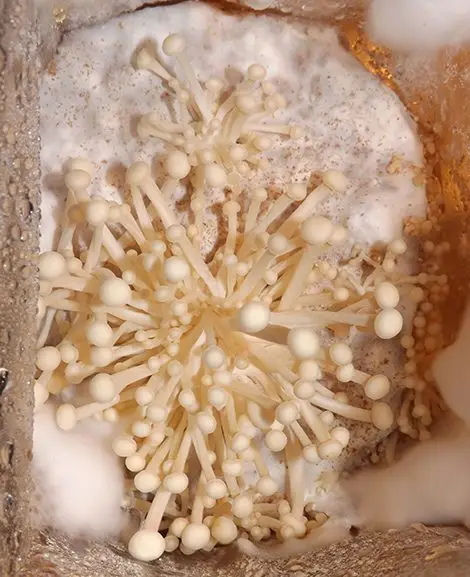The Ultimate Guide to Growing Enoki (Flammulina velutipes) Mushrooms
Enoki mushrooms (Flammulina velutipes) are a delicate, long-stemmed mushroom commonly used in Asian cuisine. Their mild, slightly crunchy texture makes them a favorite in soups, stir-fries, and salads. Beyond their culinary appeal, Enoki mushrooms are rich in nutrients, offering antioxidants, fiber, and immune-boosting properties.
If you’re interested in a Guide to growing Enoki mushrooms, this in-depth guide will walk you through every step—from selecting the right substrate to harvesting and storing your crop. Whether you’re a beginner or an experienced cultivator, this guide will help you successfully cultivate Flammulina velutipes mushrooms at home or commercially.

What Are Enoki (Flammulina velutipes) Mushrooms?
Enoki mushrooms are native to cool, temperate forests, where they naturally grow on decaying hardwood, such as mulberry, beech, and elm trees. When grown in the wild, Flammulina velutipes mushrooms have shorter stems and orange-brown caps. However, the cultivated version is grown in low-light, high-CO₂ environments, resulting in their characteristic long, thin stems and small white caps.
Why a Guide to Growing Enoki Mushrooms?
✔ Nutritious – High in fiber, antioxidants, and protein.
✔ Easy to Cultivate – Ideal for home or commercial growing.
✔ Grows in Small Spaces – Can be cultivated in jars, bags, or containers.
✔ Delicious & Versatile – Used in soups, ramen, salads, and stir-fries.
Where Do Enoki Mushrooms Grow Best?
🌱 Temperature: 45-55°F (7-13°C)
💧 Humidity: 80-90%
🌲 Preferred Substrates: Hardwood sawdust, supplemented straw, or grain
How to Grow Enoki (Flammulina velutipes) Mushrooms
Choosing a Growing Method
There are two primary methods for cultivating Enoki mushrooms:
- Growing on Sawdust Blocks (Indoor Cultivation) – Ideal for controlled environments.
- Growing in Jars or Bottles – The traditional method used for producing the long, thin cultivated Enoki mushrooms.
Method 1: Growing Enoki Mushrooms on Sawdust Blocks
Step 1: Preparing the Substrate
Enoki mushrooms grow best on hardwood sawdust supplemented with bran or rice hulls.
📌 Best Substrate Mix for Enoki Mushrooms:
- 80% hardwood sawdust (oak, beech, or elm)
- 15% wheat or rice bran (for added nutrients)
- 5% gypsum (calcium sulfate for pH balance)
- Water (enough to make the mixture feel like a damp sponge)
Alternative Substrates: Straw, sugarcane bagasse, or a mix of grain and sawdust.
Step 2: Sterilizing the Substrate
Before inoculating with Flammulina velutipes mushroom spawn, the substrate must be sterilized to kill competing bacteria and mold.
Sterilization Methods:
🔥 Pressure Cooker: Heat at 15 PSI for 90 minutes.
💨 Steam Pasteurization: Maintain at 160-180°F (70-82°C) for 24 hours.
Step 3: Inoculating the Substrate
Once the substrate has cooled to room temperature, it’s time to introduce Enoki mushroom spawn.
✔ Break up the grain spawn and mix it thoroughly into the substrate.
✔ Pack the substrate into plastic bags or jars (leaving space for air exchange).
✔ Seal the containers with a breathable filter to allow gas exchange.
Where to Buy Enoki Mushroom Spawn?
Step 4: Incubation Period
📍 Ideal Conditions for Mycelium Growth:
- Temperature: 72-77°F (22-25°C)
- Humidity: 75-85%
- Darkness: Keep containers in a dark room.
💡 Incubation Time: 14-21 days. The substrate will turn completely white as mycelium colonizes the material.
Step 5: Inducing Fruiting
After the substrate is fully colonized, it’s time to initiate fruiting conditions.
🌱 Lower Temperature: Move containers to a 45-55°F (7-13°C) environment.
💡 Reduce Light: Enoki mushrooms prefer low light or near darkness.
💨 Increase Humidity: Maintain 80-90% humidity using misting or a humidifier.
Step 6: Harvesting Enoki Mushrooms
Enoki mushrooms are ready to harvest in 7-10 days after entering fruiting conditions.
✔ Look for fully elongated stems and small white caps.
✔ Cut mushrooms at the base using a sharp knife.
Method 2: Guide to Growing Enoki Mushrooms in Jars or Bottles
This method is popular for growing long-stemmed, thin Enoki mushrooms similar to those sold in grocery stores.
How It Works:
- Use glass or plastic jars with tight openings.
- Fill the jars with sterilized hardwood sawdust substrate.
- Inoculate with Enoki mushroom spawn.
- Keep in high CO₂ environments (sealed containers).
When growing in bottles or jars, Flammulina velutipes mushrooms develop long stems and small caps, mimicking the commercial varieties found in supermarkets.
📌 Pro Tip: Keeping high CO₂ levels and low light forces Enoki mushrooms to stretch taller before developing caps.
Common Issues & Troubleshooting
1. Enoki Mushrooms Are Too Short
✔ Increase CO₂ levels by partially sealing containers.
✔ Reduce light exposure.
2. Mycelium Is Not Growing
✔ Ensure substrate moisture is not too dry or too wet.
✔ Check incubation temperature (ideal: 72-77°F (22-25°C)).
3. Contamination (Mold or Bacteria)
✔ Sterilize all equipment before use.
✔ Use high-quality Enoki mushroom spawn from reputable suppliers.
Harvesting & Storing Enoki Mushrooms
🌱 Harvesting:
- Use clean scissors or a sharp knife to cut Enoki mushrooms at the base.
- Do not pull mushrooms, as this can damage future growth.
🥶 Storage:
- Refrigerate fresh Enoki mushrooms in a paper bag for up to 2 weeks.
- Dehydrate at 110°F (43°C) for long-term storage.
Where to Buy Enoki Mushroom Growing Supplies
✔ Mushroom Spawn & Kits: Fungi Perfecti
✔ Growing Equipment & Logs: Field and Forest
✔ Enoki Cultivation Supplies: Mushroom Mountain
Final Thoughts on this Guide to Growing Enoki (Flammulina velutipes) Mushrooms
Growing Enoki mushrooms is a rewarding experience for both home growers and commercial cultivators. By carefully managing temperature, humidity, and CO₂ levels, you can produce restaurant-quality Enoki mushrooms at home.
Whether you’re using sawdust blocks or bottle-growing methods, Flammulina velutipes mushrooms are an easy and delicious way to explore the world of mushroom cultivation.
🌱 Start growing today and enjoy fresh, homegrown Enoki mushrooms!
#EnokiMushrooms #FlammulinaVelutipes #MushroomFarming #GrowEnoki #MushroomCultivation #FungiFarming





